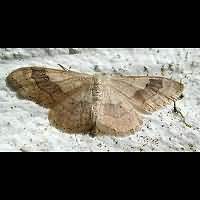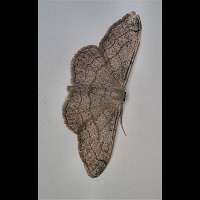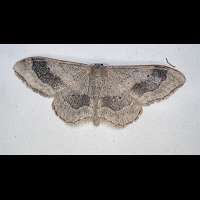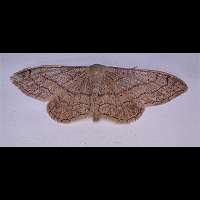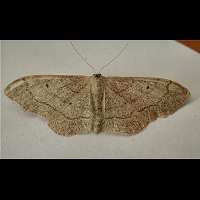Riband Wave (Idaea aversata)
Of all the waves in Britain, there are about 18 species, this is the largest. Yet the wingspan is only a meagre 30 to 35 mm. Actually there are two forms. The typical form (f. aversata) is greyish white to light brown with a broad grey bar across all wings. This form is easy to identify. The other form, called f. remutata, lacks the grey band. Only the lines that usually make the border between the band and the remainder of the wing, are there. This form is very difficult to identify, for it is often similar to the Plain Wave. If you can get a closer look though, you are able to tell the two apart, for the last line before the edge at about 4/5th of the wing is almost straight in the Plain Wave and indented in the Riband Wave. And the Plain Wave is smaller, of course. Seeing them together helps a lot, but that's a once in a lifetime chance.
The caterpillar is brown and extremely wrinkled. On top there are dark brown to black markings shaped like a V. Sometimes these merge into crosses. At the side is a long, wavy yellow line running from head to tail. The head is grey showing black markings. The young caterpillar overwinters. Once fullgrown it spins a thin cocoon in dead leaves on the ground and pupates. The larva may grow up to 25 mm. It lives on quite a few low growing plants, including bedstraw, chickweed, primrose and dandelions and is regularly discovered in gardens. The caterpillar doesn't move about a lot. When it feels threatened it pretends to be dead.
The Riband Wave has only one generation a year, but it flies about from June to mid August. The number of specimens is peaking in July, though. It only flies after dusk, but is easily attracted to lights, occasionally in great numbers. It is a very common species all over Britain and Ireland, including the Inner Hebrides and often abundant. On the continent a very common, often abundant species as well.
Of all the waves in Britain, there are about 18 species, this is the largest. Yet the wingspan is only a meagre 30 to 35 mm. Actually there are two forms. The typical form (f. aversata) is greyish white to light brown with a broad grey bar across all wings. This form is easy to identify. The other form, called f. remutata, lacks the grey band. Only the lines that usually make the border between the band and the remainder of the wing, are there. This form is very difficult to identify, for it is often similar to the Plain Wave. If you can get a closer look though, you are able to tell the two apart, for the last line before the edge at about 4/5th of the wing is almost straight in the Plain Wave and indented in the Riband Wave. And the Plain Wave is smaller, of course. Seeing them together helps a lot, but that's a once in a lifetime chance.
The caterpillar is brown and extremely wrinkled. On top there are dark brown to black markings shaped like a V. Sometimes these merge into crosses. At the side is a long, wavy yellow line running from head to tail. The head is grey showing black markings. The young caterpillar overwinters. Once fullgrown it spins a thin cocoon in dead leaves on the ground and pupates. The larva may grow up to 25 mm. It lives on quite a few low growing plants, including bedstraw, chickweed, primrose and dandelions and is regularly discovered in gardens. The caterpillar doesn't move about a lot. When it feels threatened it pretends to be dead.
The Riband Wave has only one generation a year, but it flies about from June to mid August. The number of specimens is peaking in July, though. It only flies after dusk, but is easily attracted to lights, occasionally in great numbers. It is a very common species all over Britain and Ireland, including the Inner Hebrides and often abundant. On the continent a very common, often abundant species as well.

